According to research from Salesforce, 75% of business buyers expect the companies they buy from to provide personalised experiences, anticipate their individual needs and provide relevant suggestions.
Separate research has found that 57% of online buyers are happy to exchange personal data in return for personalised offers or discounts. While a similar majority of 58% say personalised experiences are important when buying from a company.
There’s a lot of talk about personalisation in the marketing industry these days but it’s important to understand this is a subject that matters to business and consumer buyers themselves. This isn’t just another buzz term doing the rounds at marketing conferences and tech shows; this is one of the trends that matter most to the people you want on your customer list.
If you haven’t got a sold personalisation strategy in place, you’re in danger of falling behind competitors who deliver the experiences your target audiences are really looking for. The aim of this article is to show you how widespread personalisation already is across brands of different sectors and sizes, as well as how many different approaches there are to provide a more compelling customer experience.
Here are 30 brands that are already killing it with personalised customer experiences.
- Pull&Bear’s navigational approach to personalisation
- Amazon’s product recommendations
- Coca-Cola’s “Share a Coke” campaign
- Spotify’s account customisation
- StitchFix’s personalised business model
- Grammarly’s weekly reports
- The Venture Harbour Harbour personalisation plugin
- Starbucks’ gamified app
- Very’s weather personalisation strategy
- Personalised lead generation
#1: Pull&Bear’s navigational approach to personalisation
Every conversation about marketing personalisation seems to revolve around user data, suggesting it’s not possible to deliver personalised experiences without getting your claws on personal info. While it’s true that you can do so much more when you have relevant data on your side, you can create personalised experiences without it and you don’t need to wait until you’ve got users handing over data to start doing so.
Clothing retailer Pull&Bear is proof of this with its navigational approach to personalisation. For new visitors, the session starts by asking users if they want to browse women’s or men’s clothes and the site continues to navigationally personalise the experience from there.
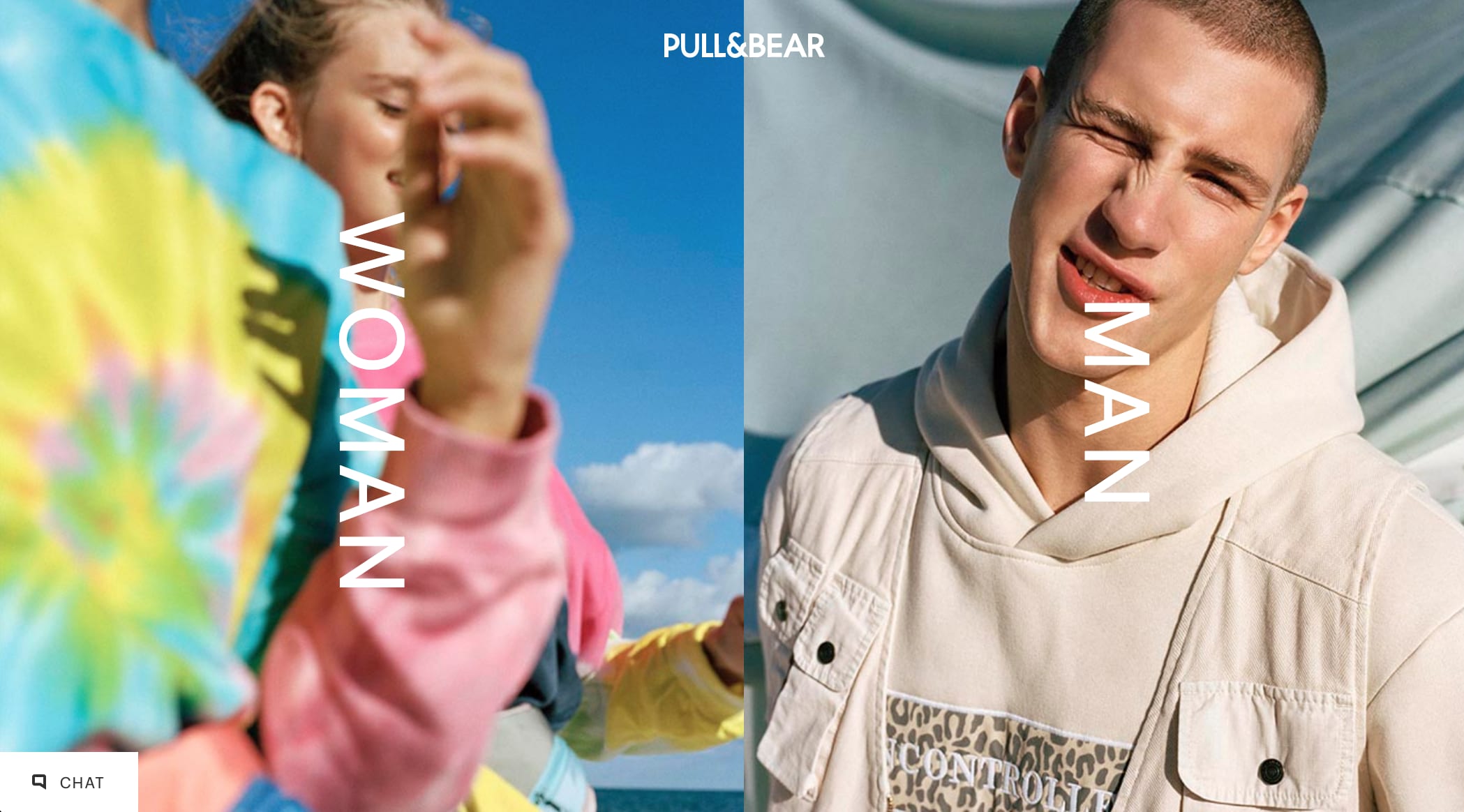
This doesn’t require any data whatsoever but it does create a more relevant and personalised experience that’s intuitive every step of the way. Pull&Bear does ask users for consent to store their data for future sessions but the experience doesn’t rely on this data exchange and users are never denied access to anything for refusing to give consent.

User choices can be remembered via cookies and the experience becomes even more personalised when users create accounts, buy products and engage with the brand. But Pull&Bear is providing personalisation from the very first visit for every user, regardless of when they convert.
#2: Amazon’s product recommendations
One of the most famous examples of personalisation is also one of the most successful. Amazon’s product recommendation engine reportedly contributed to 30% of the e-commerce giant’s revenue by 2015 and, in theory, it’s recommendations should only be more effective with five years worth of additional data running through its algorithms.
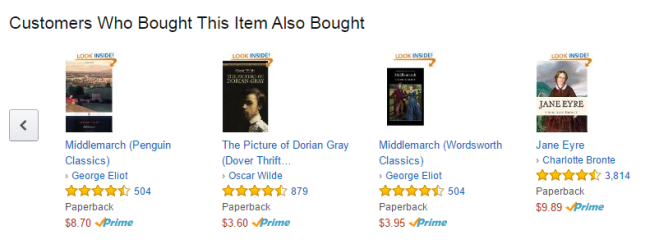
There are plenty of product recommendation engines on the market, promising to deliver a similar experience for B2C and B2B retailers. Keep in mind that product recommendations are routinely cited by customers as one of the most desired forms of personalisation.
#3: Coca-Cola’s “Share a Coke” campaign
Coca-Cola offered up another example of (mostly) data-free personalisation with the Share a Coke campaign, which was created by Ogilvy.
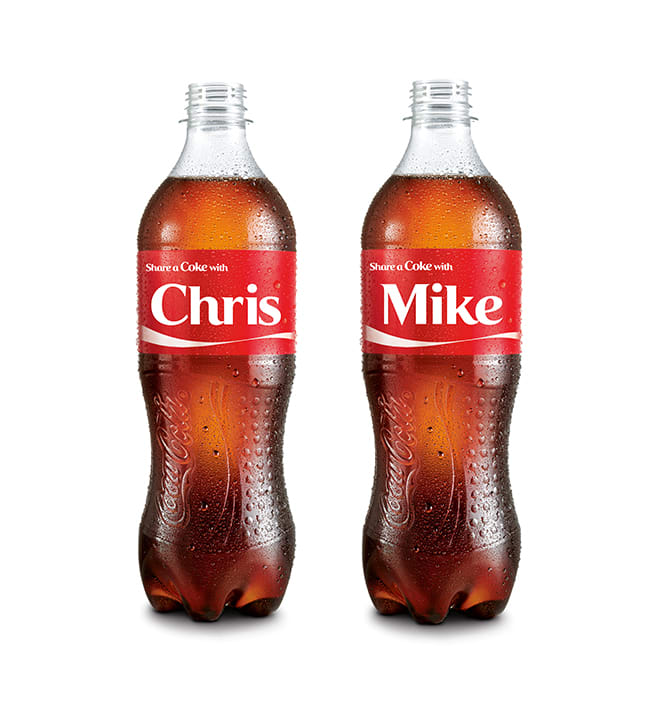
With 50% of teens and young adults having not enjoyed a Coca-Cola in the previous month alone – we had to reconnect with our key audience. We printed the 150 most popular Australian names on Coke bottles and cans and invited Australians to ‘Share a coke’. The rest is History.
The campaign ran in over 80 markets over a seven-year period, featuring popular names in countries from Australia to Vietnam. The campaign reversed an 11-year consumption decline in the US and helped the drinks brand boost its presence across international markets.
It also proved offline personalisation can be effective, too.
#4: Spotify’s account customisation
Spotify’s music recommends are designed to keep users engaged with the platform and consuming content but this isn’t the only way it uses hyper-personalisation. In fact, I would argue the streaming app’s most effective use of the technology lies in the extensive user account customisation that’s made possible.
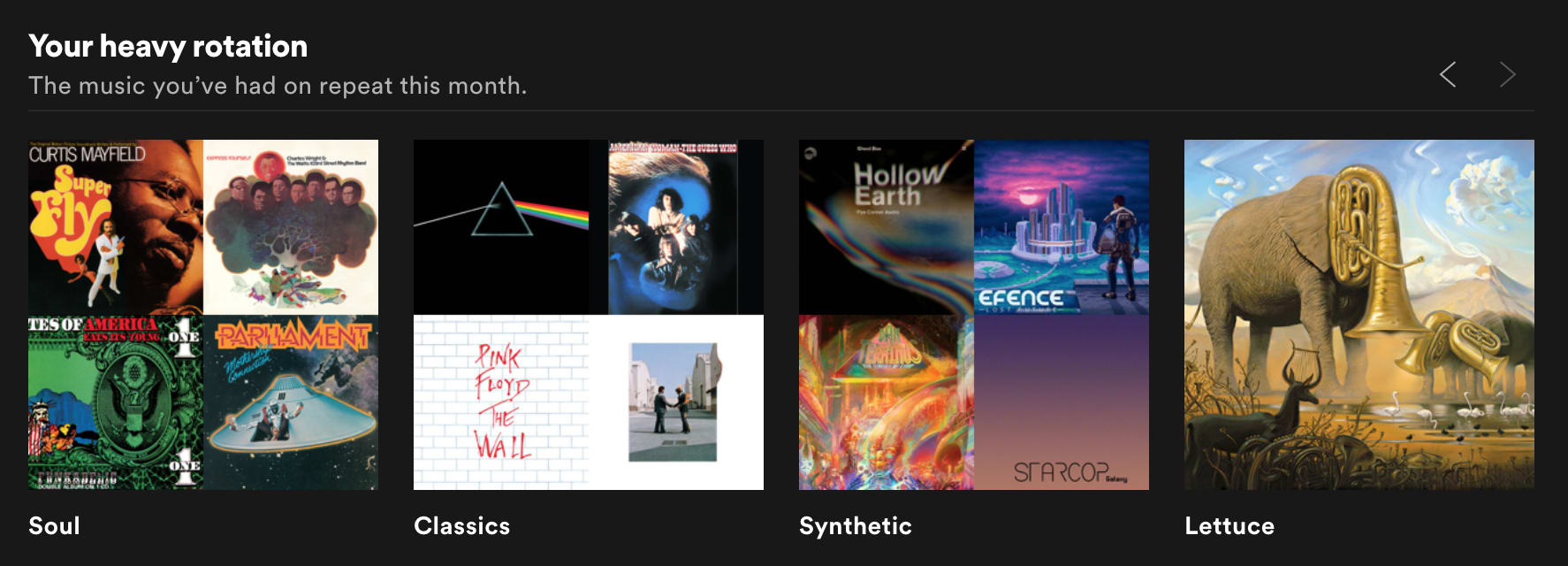
Spotify encourages users to create their own playlists, essentially building an entire library of music on their account. Over the past ten years or so, I’ve gradually created hundreds of playlists with thousands of tracks assigned to my account – I couldn’t even guess what the actual numbers would be.
Why does this matter?
Because I can’t image the prospect of ditching Spotify and recreating those playlists on another platform (or losing them altogether). I’ve invested way too much time into Spotify and, as a result, I’m locked into paying for a premium account – quite happily, too.
#5: StitchFix’s personalised business model
Some of the most impressive examples of personalisation come from brands that turn it into an entire business model, delivering 100% personalised experiences for every customer.
Clothing retailer StitchFix turns the online shopping experience on its head by treating every customer as an individual. The startups isn’t merely selling clothes, it’s selling personalised style recommendations – entire wardrobes curated for each customer, based on their personal preferences, sizes and feedback.
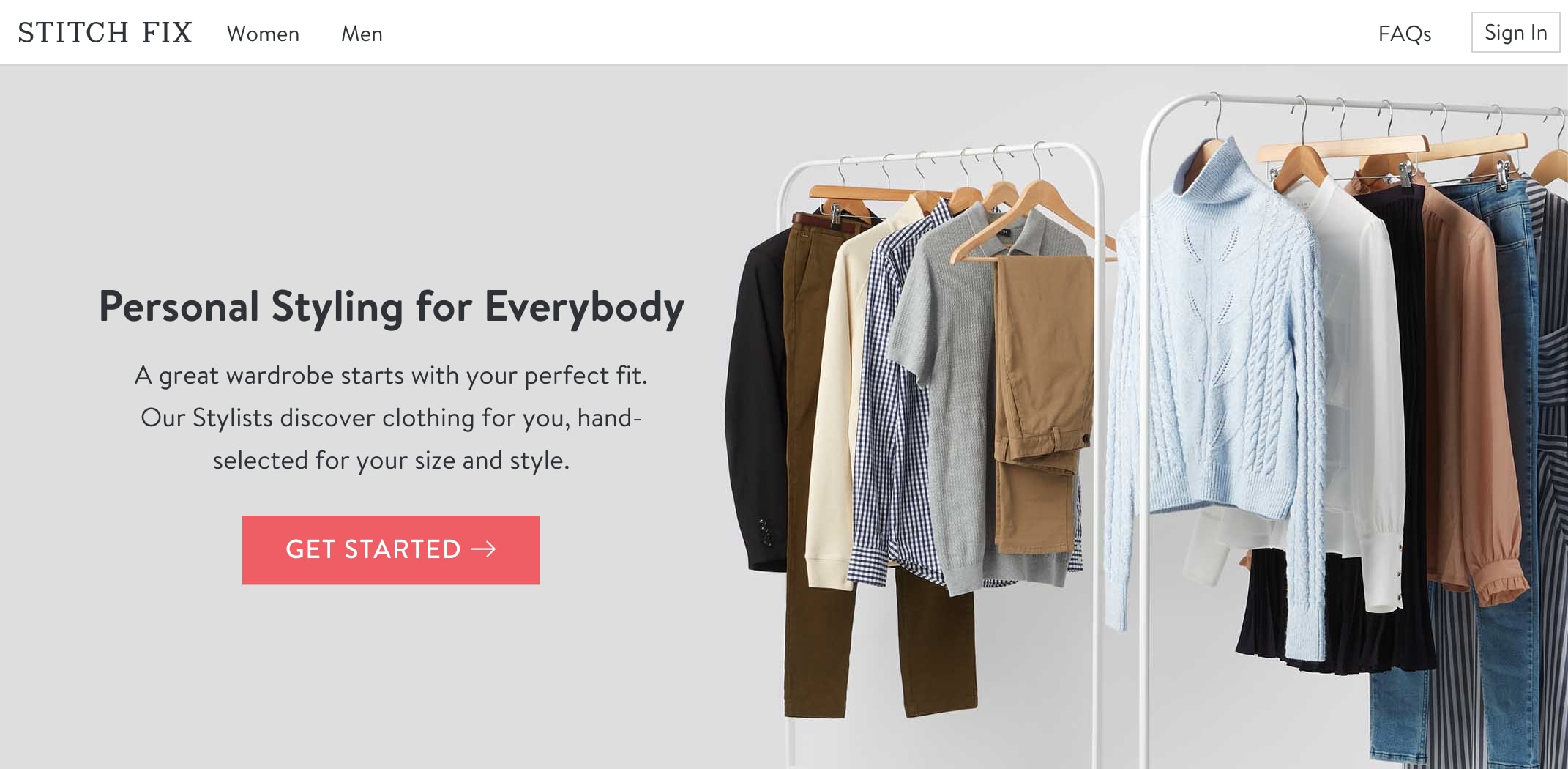
Users provide relevant data about themselves – sizes, style preferences, favourite colours, etc. – and StitchFix analyses this data against the clothing patterns of consumers with similar tastes.
That’s not all, though.
StitchFix also has a team of more than a thousand human personal stylists who assess user profiles and provide expert stylist recommendations. Users then receive their recommendations in the post to try for themselves and they only buy what they like.
Humans and machines, working together in harmony.
As a result, StitchFix delivers a truly personalised customer experience from the very first interaction – and the service only improves as it learns more about individual users.
#6: Grammarly’s weekly reports
Grammarly makes use of all the data it collects from its users to deliver weekly reports, providing an analysis of their writing technique. For the end user, this allows them to see how their writing has progressed since they’ve been using the app and pinpoint areas where they still need to improve.
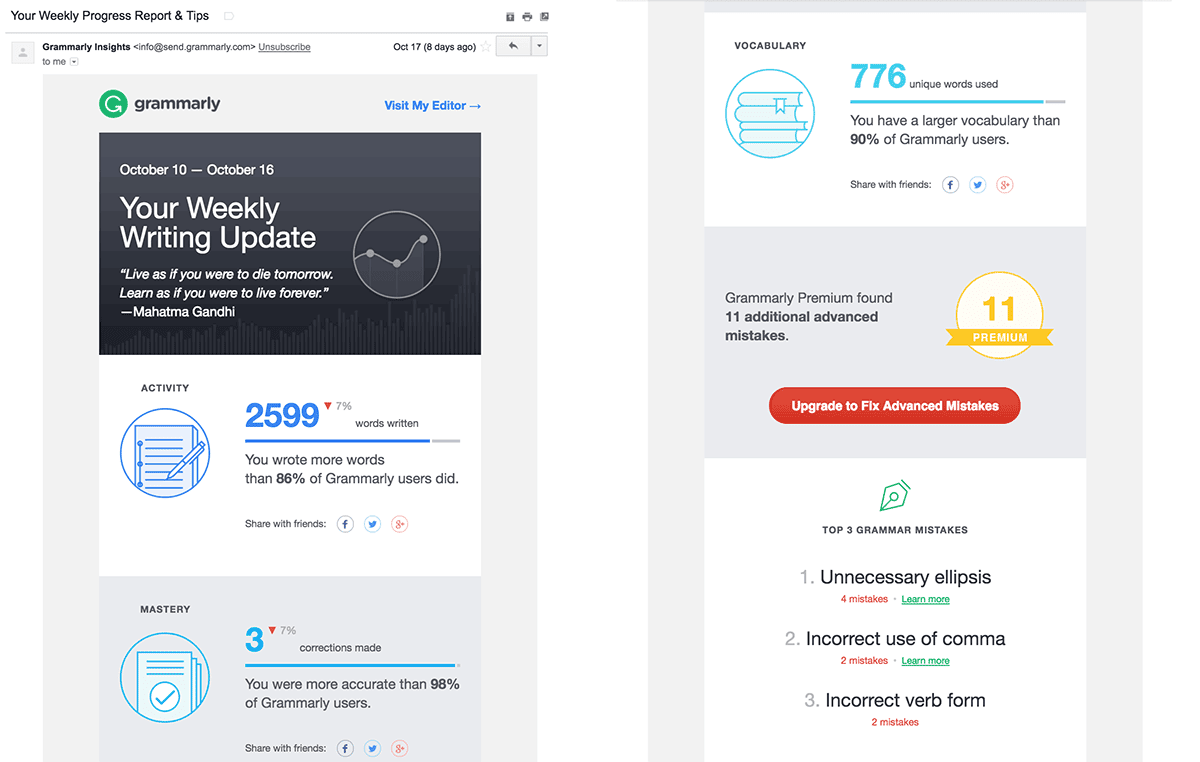
Crucially, though, the real function of these reports is to show users how valuable the app is to them, establishing it as a vital tool for content creators, writers or people worried about silly typos in their emails. It also acts as an upselling strategy, reminding users that they’ll get even deeper insights into their writing habits and fix more problems if they upgrade to a paid account.
#7: The Venture Harbour Harbour personalisation plugin
Twice a year, the entire Venture Harbour team goes on a retreat to teach each other new skills, solve interesting problems, and build new products.
After a morning experimenting with content personalisation platforms, we realised that most content personalisation tools suck. Between GDPR limitations, annoying flicker effects and clunky user interfaces, we felt as though most of these tools had sold the sizzle well… but no sausage.
There was also no tool that simply allowed us to personalise content based on the answer to a question, without having to configure JavaScript variables, custom attributes and blah.
So, in an afternoon during our retreat, the team built one!
The WordPress Content Personalisation Plugin.
Within 7 days we saw a sharp increase in engagement:
- 37.59% increase in average time on page
- 12.9% reduction in bounce rate
In addition to this, we saw an 88% increase in people clicking through to an email marketing tool, almost doubling the affiliate revenue generated from the content.

We also saw a sharp increase in rankings (resulting in a 53% increase in search traffic) within 3-4 weeks of adding this content personalisation. As this was one of the only changes we had made to this post in a long time, it’s possible that the improved engagement metrics were a contributing factor to increase rankings.

You’ll struggle to find a more simple personalisation technique that has this kind of impact.
#8: Starbucks’ gamified app
Starbucks’ mobile app has been so successful it was the most commonly-used platform for mobile payments until late 2019 when Apple Pay finally overtook the coffee brand.
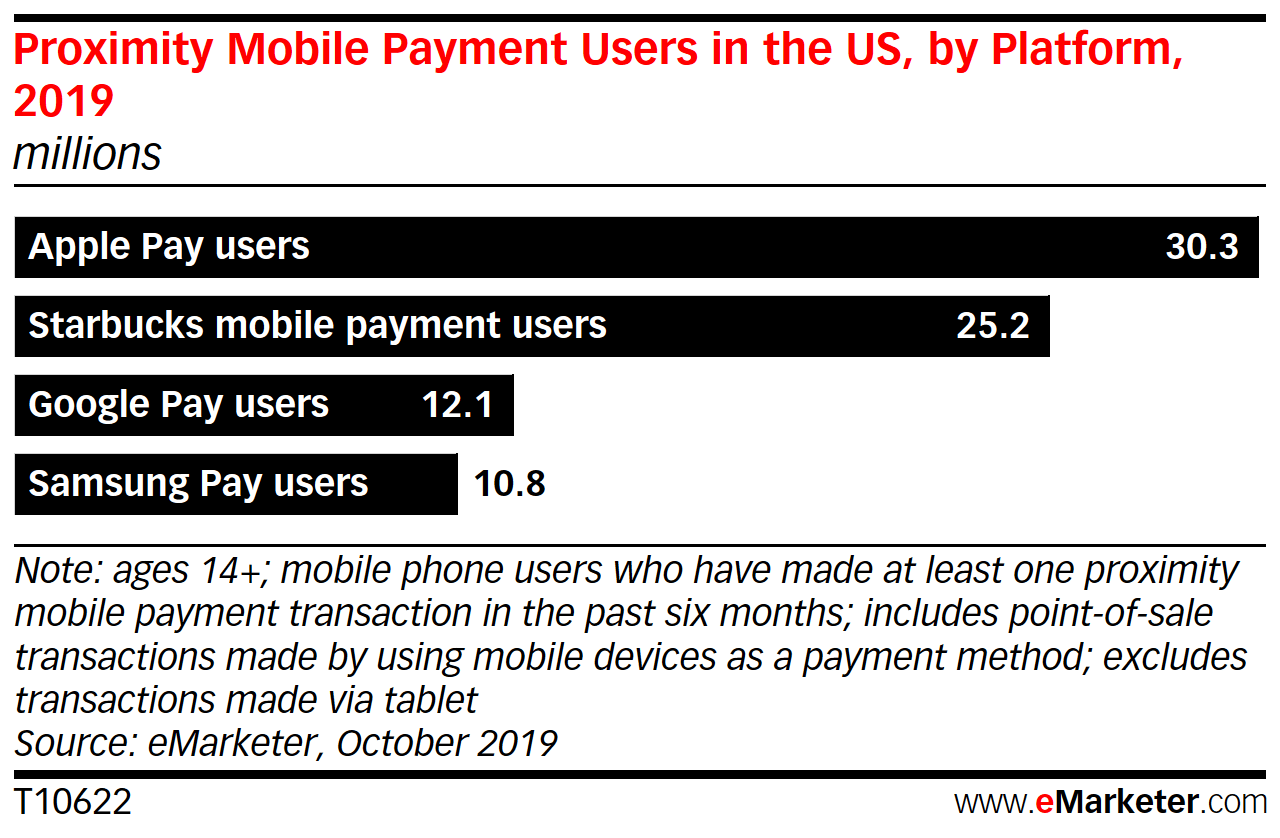
Let’s be clear, the Starbuck’s app is not an online payment platform but it continues to dwarf the likes of Google Pay and Samsung Pay users in terms of online payments made in the US.
That’s how popular this app is.
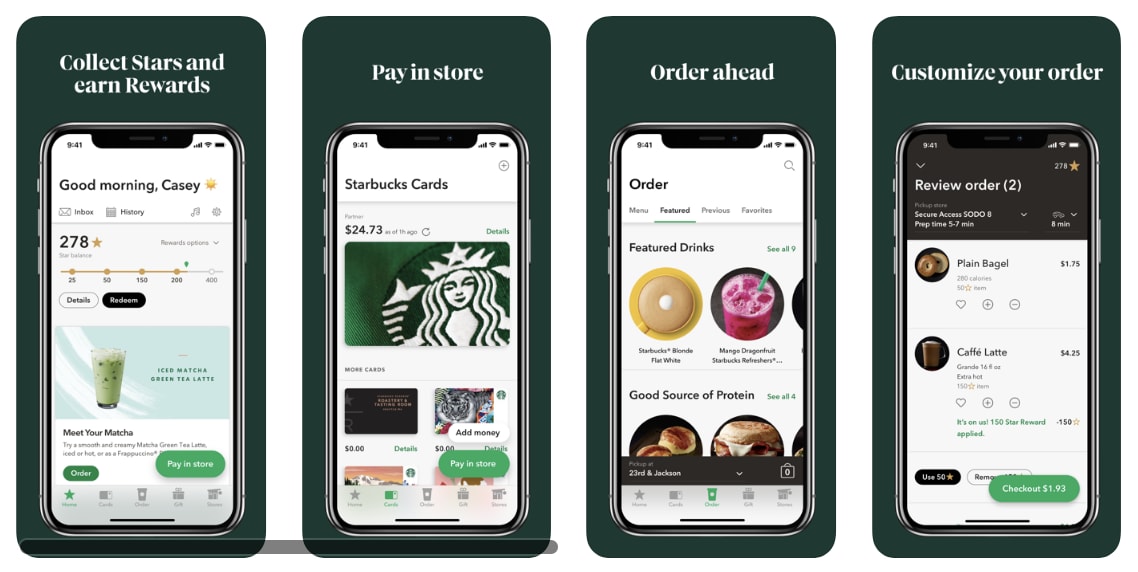
The reason for this popularity has a lot to do with the popularity of Starbucks itself but the personalised experience the brand delivers through its mobile app is the key to its success. Customers can place orders and pick them up in-store and Starbucks has also gamified the customer experience by rewarding them with points for every purchase, which can be exchanged for freebies at a later date.
#9: Very’s weather personalisation strategy
Weather patterns impact the way people buy online and Very has responded to this by testing personalised content based on local weather patterns for users. So, if you’re sweltering in the summer heat, Very can deliver content and product recommendations for light, cool clothing options.
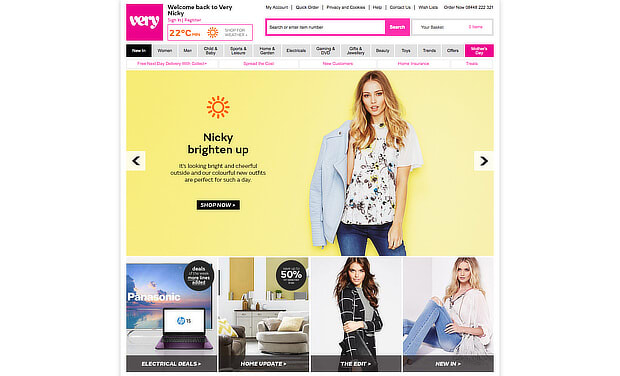
On the other hand, if you’re caught in a downpour and realise you haven’t got a suitable waterproof, Very can anticipate your needs based on the weather in your local area.
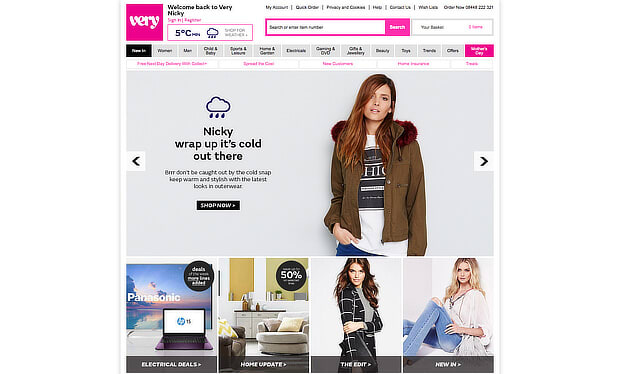
Brands have been slow to use weather data as a personalisation tool, despite it playing a huge role in a wide range of purchase decisions. This is something that needs to change and Very was an early adopter of the technique.
#10: Personalised lead generation
Marketing Automation Insider personalises the lead generation process by asking users what they need.
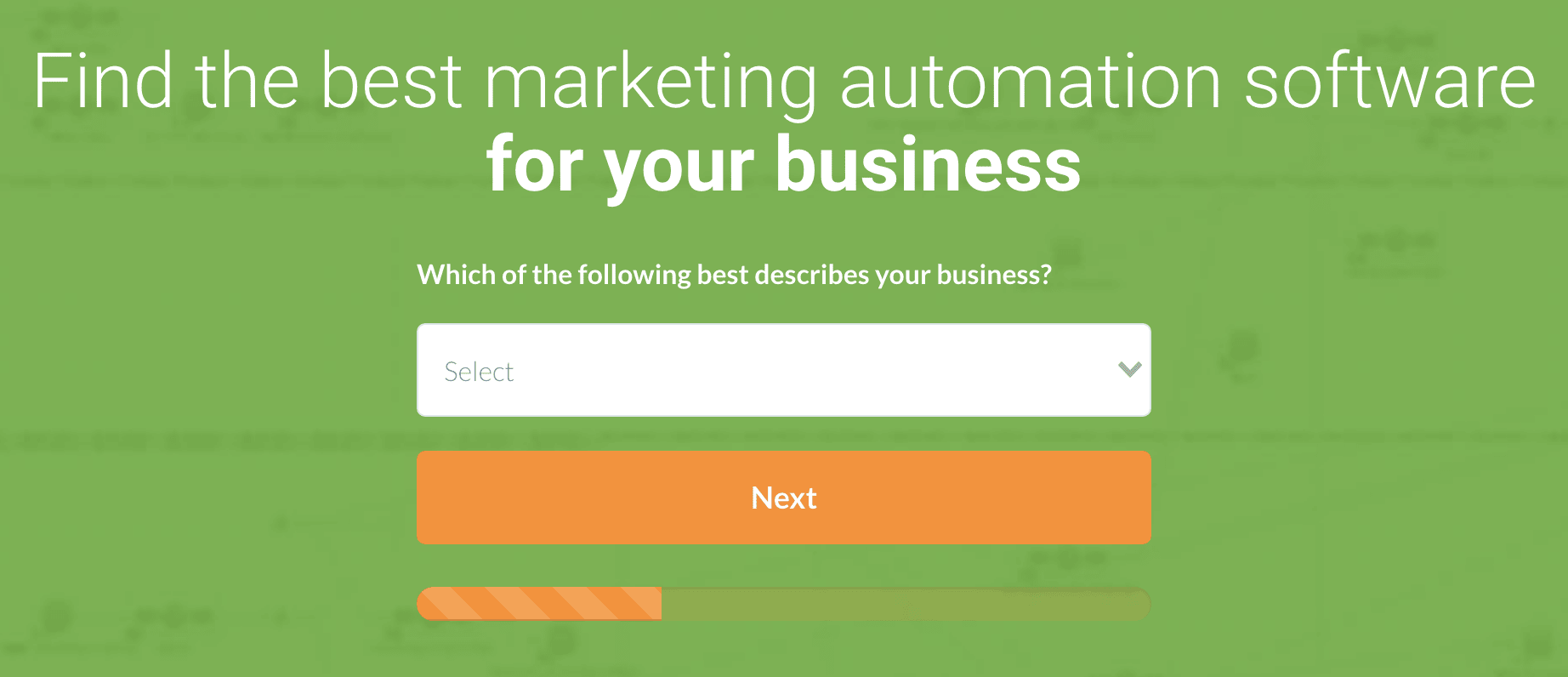
Users provide information about their software needs, which refines the options the website provides as recommendations. The more info users submit, the more relevant the recommendations will be and Marketing Automation Insider allows users to get a free report sent to them by email.
It’s a great example of personalised lead generation, instead of generic content downloads.
#11: NetFlix’s content recommendations
After Amazon’s product recommendations, this may be the second-most famous example of personalisation. In terms of usability, Netflix’s content recommendations mean users don’t need to browse the platform to find something new to watch.

However, more importantly, the machine learning algorithms behind it allow Netflix to learn more about users and make compelling recommendations that will keep people using the paid streaming services. This is an important example of how content personalisation can keep subscribers paying for a service.
#12: Evergage’s personalised search results
Search functions are crucial for online retailers but Evergage doesn’t want brands to deliver generic search results. Instead, its personalisation platform allows brands to deliver individualised search results, based on the interests of each user.
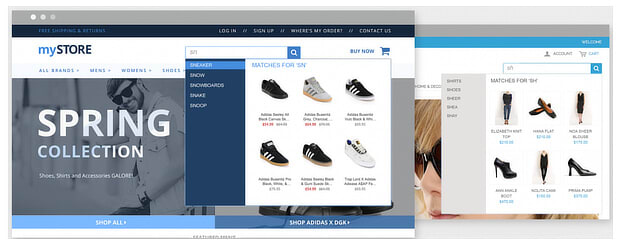
Visitors who use your on-site search functionality are telling you exactly what they’re looking for, and it’s beneficial for you to help them find it quickly before they move on. Direct them to the products that they are looking for right in the search bar itself by using algorithms to surface the most relevant items for each person based on the brands, categories, price ranges, etc. they have already shown affinities for on your site. Search results that consider each person’s preferences and intent will show products that are relevant to the individual, not just to the search term, for maximum relevancy.
That makes a good case for delivering personalised search results, instead of returning the same set of results to everyone submitting the same query.
#13: easyJet’s personalised customer stories
Back in 2015, easyJet embarked on a hyper-personalised marketing campaign to celebrate its 20th anniversary. In a year when the likes of eBay and FT.com were also marking their 2oth birthday’s, easyJet’s campaign stood out above them all because it put its customers at the heart of its own celebrations.
The multi-channel campaign was centred around TV and social media ads featuring images from easyJet customers on their travels over the previous 20 years. The company later printed these images onto the side of one of its planes and compiled curated “top 20” lists and travel guides from its customers.

A lot have brands have tried to make the most of user-generated personalisation in recent years and many have failed spectacularly. However, easyJet nailed this with its anniversary campaign by aligning its business journey with the best and most memorable moments its customers have enjoyed from its services.
This campaign wasn’t really about easyJet; it was about its customers and this is what the end consumer wants to see from hyper-personalisation.
#14: Tesco’s Clubcard
Tesco’s Clubcard program has been around for so long now, it’s easy to forget it’s one of the most successful personalised marketing campaigns ever run in the UK.
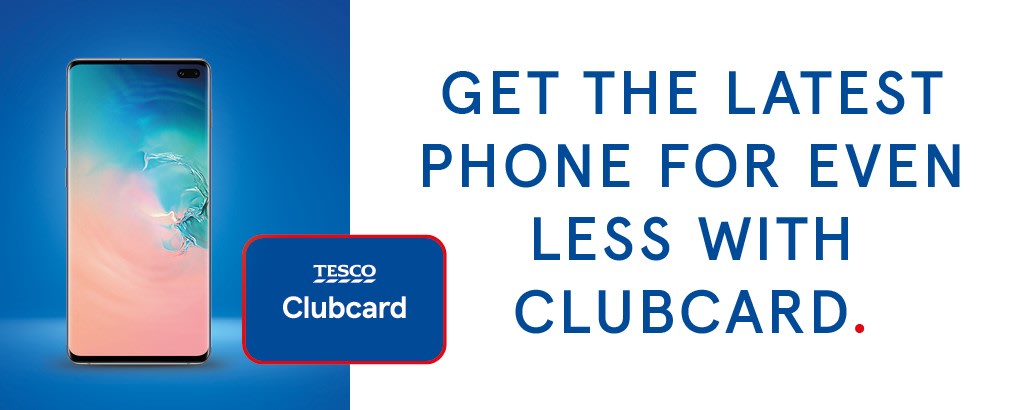
The UK retailer has upped the game this year with its Clubcard Plus subscription service that promises to save customers even more money and deliver a wide range of extra benefits for £7.99 a month.
The role of Tesco’s traditional Clubcard service was to assign purchase data to its customer’s personal data: demographics, budgets, other purchases, etc. Now, the retailer is attempting to bring big spenders back into its stores and only time will tell whether it is as effective as its predecessor.
#15: Secret Escape’s website personalisation
This example was featured in a Smart Insights article back in early 2019, entitled The best examples of essential personalizations from across the web. Essentially, travel brand Secret Escapes adapts its on-site experience, depending on the keywords typed into Google Search.
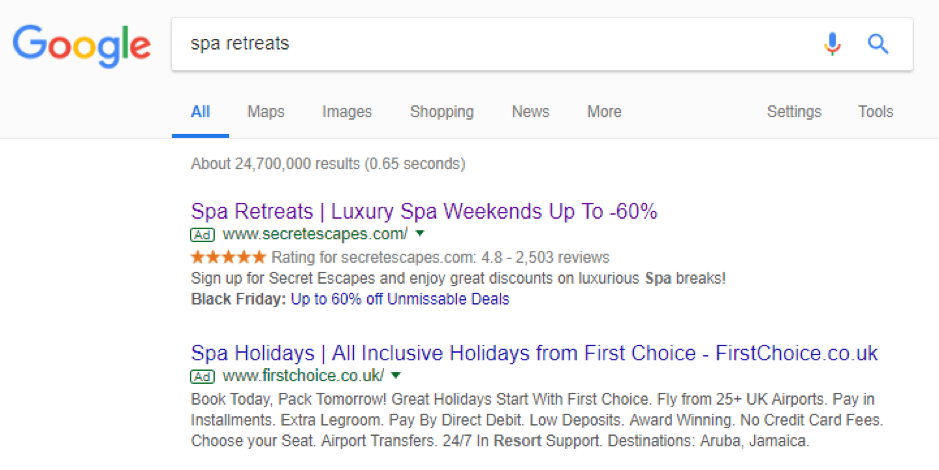
As you can see, the copy and images on the site are delivered to match the purchase intent of the user.
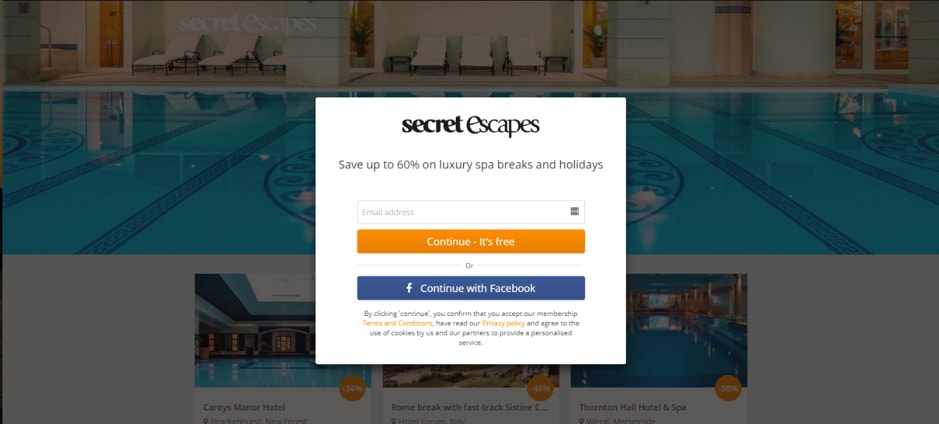
Secret Escapes is by no means the only brand using this technique and it’s a relatively easy strategy to implement, using truncated URLs.
What’s great about this personalization is that updating content based on PPC search term is relatively easy since information about the paid search ad group and campaign is available in the referring URL query string.
This is a good example of tapping into Google data to deliver a personalised experience that matches the unique desires of individual users.
#16: Argos’ personalised social Xmas campaign
Christmas campaigns are traditionally dominated by the like of John Lewis with their emotionally-driven storytelling ads. However, these days, the likes of Amazon, Lidl, ASDA, M&S and just about every UK retailer seems to be pumping out the same type of festive ads that collectively fail to distinguish themselves from each other.
In 2017, Argos tried something a little different with its Christmas ad by ditching the sentiment aspect and focusing on personalisation. Here’s what eConsultancy had to say about the campaign:
It’s a decent enough ad, however, in order to build further hype and engagement Argos is also giving consumers the chance to be featured in a personalised version.
Encouraging parents on Facebook to submit pictures of their kids, it will send winners their own ad to share on social media, as well as pick a lucky three to feature in ads aired on television.
As eConsultancy points out, this campaign worked for Argos but many brands like Walkers and the National Lottery have failed miserably with similar campaigns that were hijacked by users submitting controversial content and failing to deal with this eventuality.
However, done correctly and with the right safeguards in place, these user-oriented campaigns can work wonders.
#17: DeepSky’s personalised calculator
DeepSky calls itself the “Entrepreneur’s Accounting Department,” promising to help creative business minds measure, visualise and hack their ventures to success. To boost lead generation, the company has integrated a personalised calculator in the Free Tools section of its website.

In a similar way to the Marketing Automation Insider examples, we looked at earlier, DeepSky’s calculator asks users questions about their business and provides a customised response based on the information they provide. The calculator is then able to provide users with an estimate on how much they should be paying on accounting per year in order to maximise business performance.
Once again, this helps DeepSky generate engaged leads but the data users submit also allows the company to score and prioritise leads, based on the value of them to the company.
#18: Care/of solving personal problems
Care/of essentially uses the same business model as StitchFix, which we looked at earlier: providing 100% personalised services for every customer. The difference is that, rather than offering up fashion advice, it aims to solve an even more personal problem.
The homepage leads with the following message on its hero section:
Take care of your energy, diet, stress, sleep… life
All users need to do is take a quick quiz and Care/of creates a plan of vitamins and supplements designed to help them feel better and boost their everyday health.
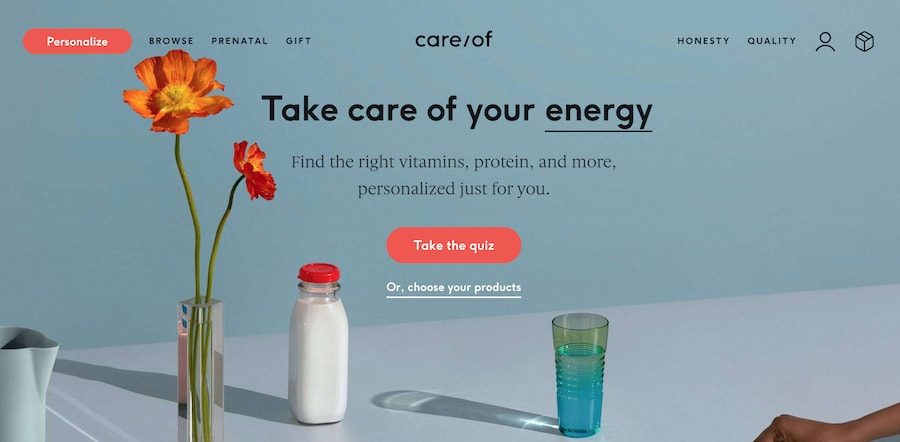
This plan changes as people progress through their initial course and their health reaches certain landmarks – all of which is logged in the mobile app. Users receive new recommendations as their journey progresses and everything is 100% personalised to their unique needs.
#19: NakedWines’ score-based recommendations
Naked Wines takes has created a personalised customer experience that revolves around wine recommendations, based on user reviews. Basically, customers rate wines they’ve tried and the site then recommends other wines to try based on their feedback.
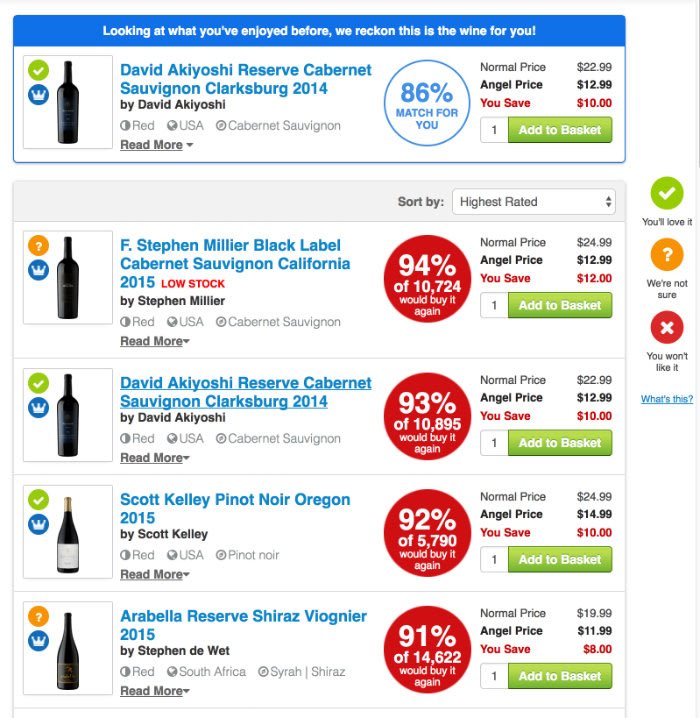
Naked Wines isn’t a huge company and it doesn’t have the vast array of user data to work with that brands like Amazon and Netflix are built around. However, the UK retailer proves that effective personalisation can be achieved with a relatively modest amount of customer data.
#20: ModCloth’s online window shopping
Clothing retailer ModCloth understands that people sometimes want to window shop while other times they might want to buy on impulse or take their time with a more calculated purchase decision. The company also understands that the same person can choose to shop in all three ways (and many others) when the mood takes them.
So the retailer has created a website that allows users to like items, save them to lists and browse without any pressure to click the buy button (when the mood doesn’t take them).
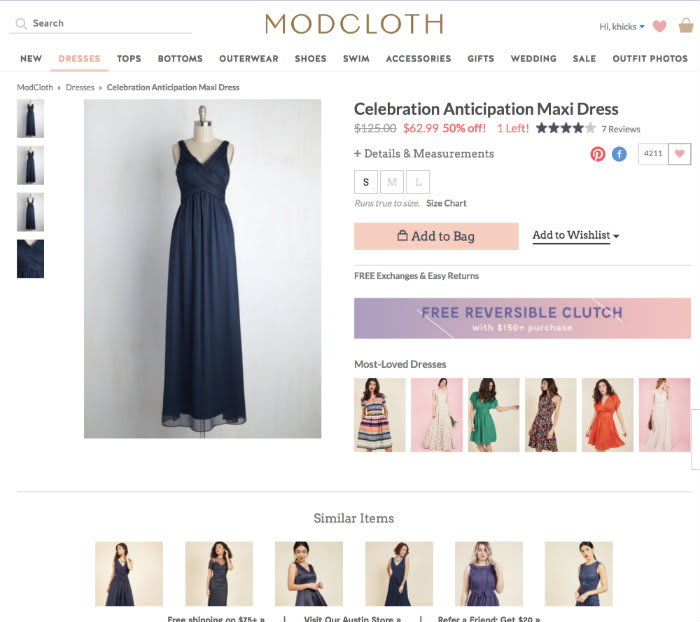
The website is all about engagement but the soft-selling approach also allows ModCloth to build a larger dataset for each user, based on their likes and interests. This provides all the info the brand needs to target users with highly-relevant email offers, product recommendations and updates.
#21: House of Kaizen’s targeted landing pages & email strategy
House of Kaizen increased the online ROI for Nuffield Health by delivering personalised emails based on landing page interactions.
House of Kaizen was tasked to increase click-through rates and lead generation conversion rates. We used highly tuned banners and emails that drove traffic to bespoke and optimised landing pages, where traffic was funneled through to conversion.
House of Kaizen achieved this by creating dedicated banners and bespoke emails including designs and content to power the online marketing campaign:
- Emails: Custom-made for each traffic segment.
- Banner ads: Tuned to each affiliate network.
- Relevant content strategy: Formulated to increase engagement, convert leads, complete goals, lower exit rates, and reduce Cost per Lead.
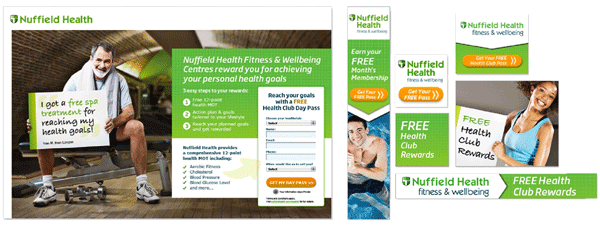
By integrating multiple strategies, House of Kazen was able to achieve significant results from relatively simply personalisation across multiple channels.
#22: Graze
Healthy snack company Graze is another brand built around data-driven personalisation. Customers share their snack likes, dislikes and allergies and receive a regular subscription box full of personalized goodies. This data allows the company to deliver personalised snack recommendations comprising of around 500 products and 200 million possible combinations.
Graze says its algorithms use 300 million customer ratings of its products at a rate of 15,000 an hour, as well as other factors. This allows the brand to customise snack boxes are based on data straight from the consumers, along with other elements like nutrition and variety.
This is a fine example of how data-driven personalisation is one of the most effective modern business models.
#23: Unbounce’s Dynamic Text Replacement
More than an example of personalisation, this is a feature that will allow you to deliver personalised experiences. Earlier, we looked at how Secret Escapes delivered on-page experiences based on the keywords users type into Google Search and Unbounce’s Dynamic Text Replacement feature is designed to do just that.
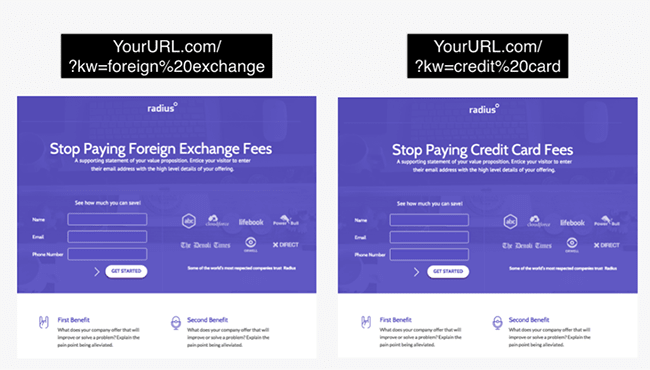
It works by matching the copy in your PPC ads to the copy on your Unbounce landing pages, so you can deliver relevant content to users based on the same message that encouraged users to click in the first place.
#24: Henri Lloyd’s fitting recommendations
StitchFix isn’t the only online retailer that wants to find the perfect fit for every customer and Henri Lloyd ensures its users never need to worry about ill-fitting clothes – one of the biggest frustrations of buying clothes online.
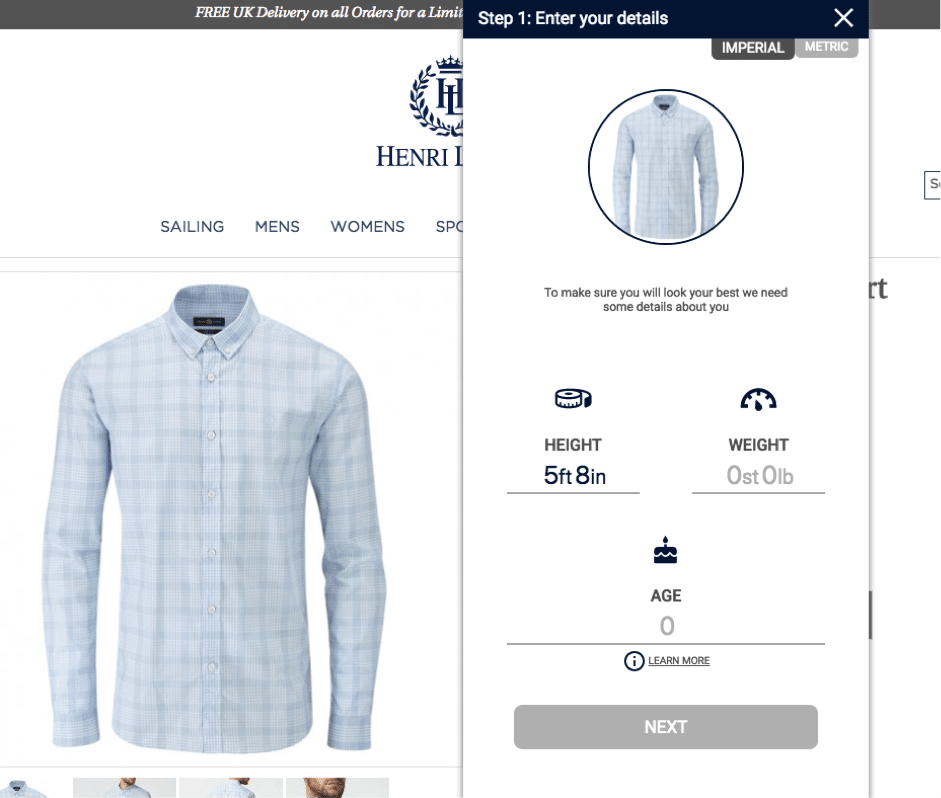
The website prompts users to enter details like height, body shape, weight, etc. so its algorithm can make personalised size recommendations throughout the experience.
#25: Vi, the digital personal trainer
Vi is a personalised digital training app designed to encourage people to get out and run more often. The app promises to help people hit their fitness targets or give them their money back. The idea is to provide feedback data from every run and build a journey of progress that motivates users to keep reaching milestones.
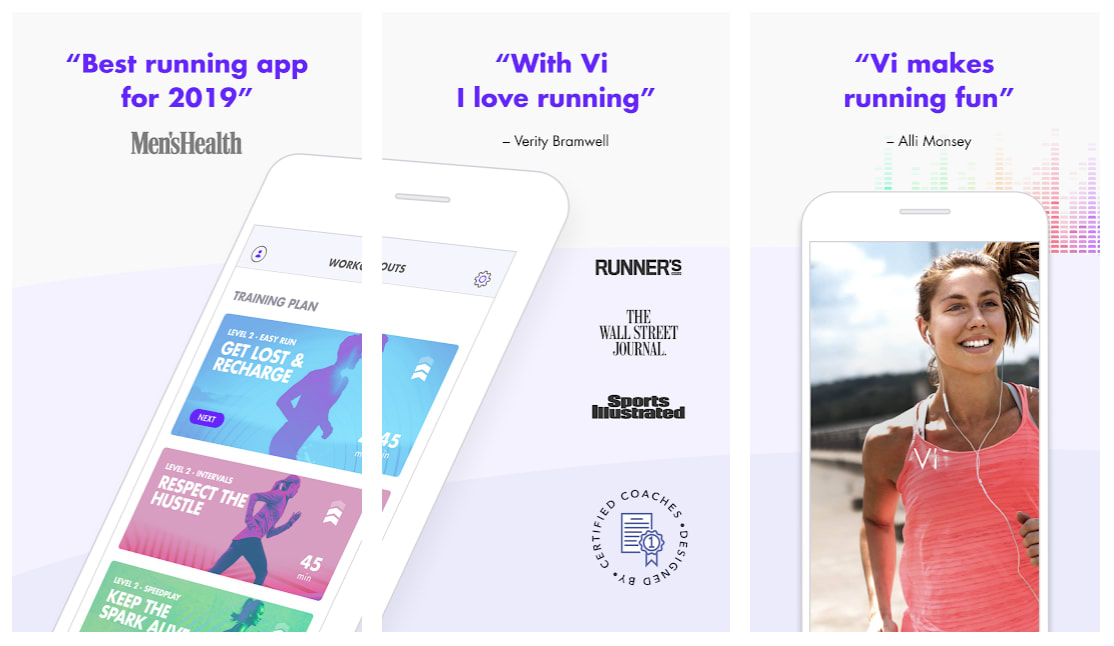
Vi learns from user data to set realistic goals, provide valuable tips and integrate with other apps like Google Fit, Apple HealthKit and Spotify Premium. The app also allows users to run as part of an online community and compete against each other while also rewarding users for reaching achievements – all for a one-off fee that’ll cost far less than a year’s gym membership.
#26: Adidas’ gender email segmentation
This example of personalised email marketing is brought to us by Campaign Monitor, courtesy of Adidas. As the Campaign Monitor article explains, “rather than sending a generic email to all customers with all their shoes, Adidas segments their lists based on gender. Then they can send an email highlighting hip, new men’s shoes to their male customers, and cute women’s shoes to their female customers.”
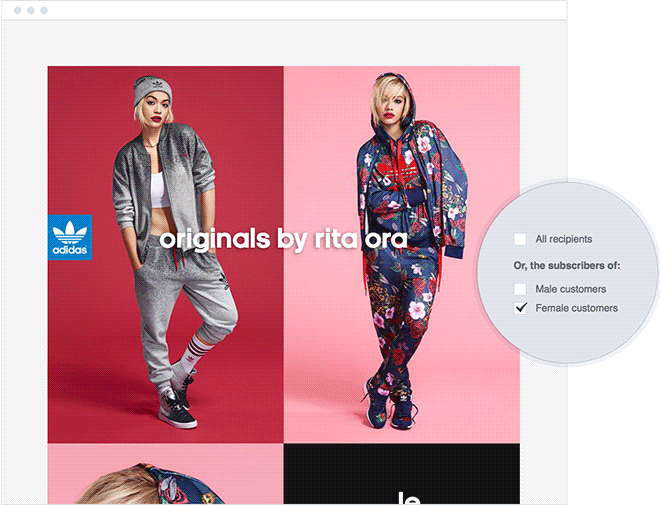
This is a simple but crucial example of personalisation for brands looking to maximise email engagement, conversion rates and customer retention.
#27: Mack Weldon combines cart abandonment and recommendation campaigns
Another tried and tested method of creating personalised customer experiences is cart abandonment campaigns. However, Mack Weldon has taken this one step further by combining abandonment campaigns with product recommendations to bring users back to their cart and tempt with similar options.
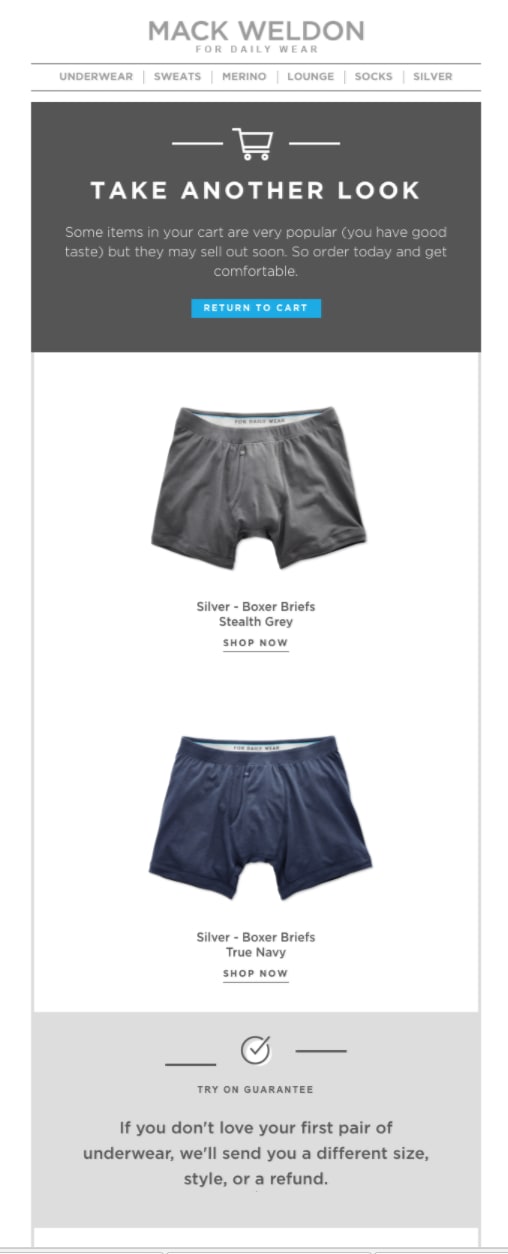
Instead of trying to convince users to complete the same action they failed to complete first time around, these campaigns aim to tempt users with fresh options and refresh their purchase intent.
#28: Monica Vinader makes it personal
In another Campaign Monitor example, Monica Vinader combines the classic name insertion technique with personalised images to include the initials of people on their email lists.
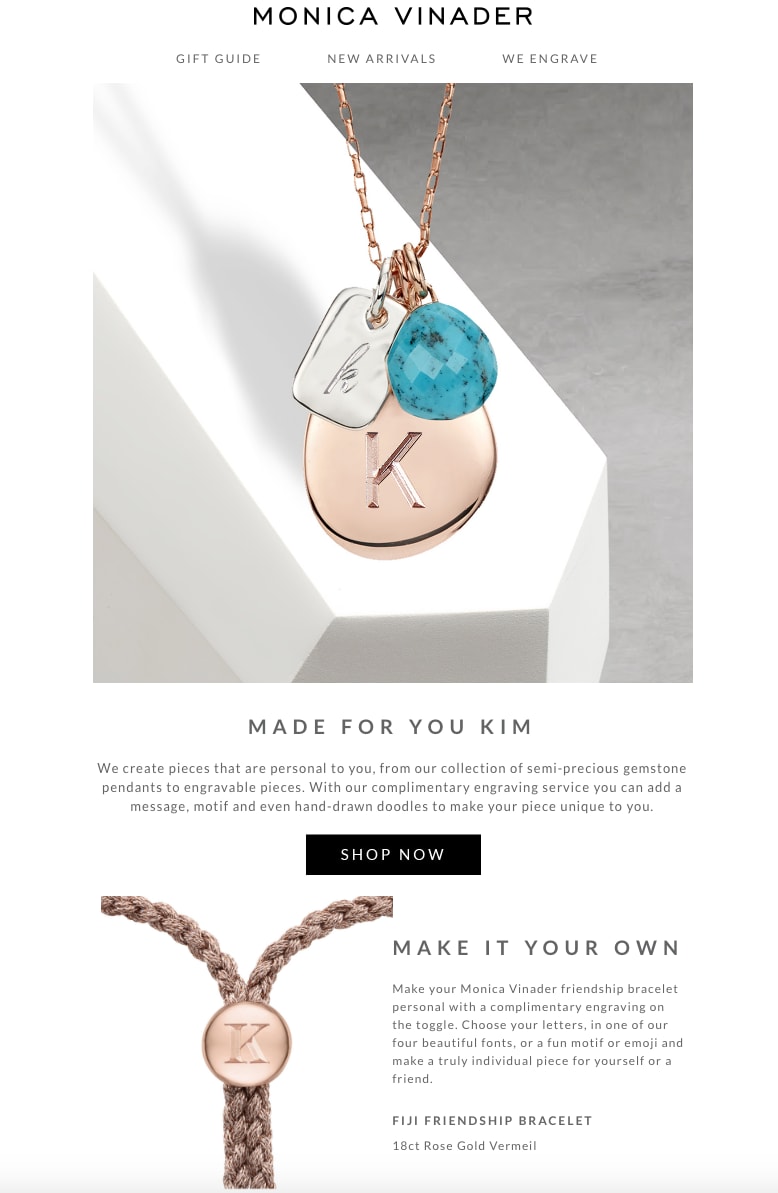
The entire email campaign is built around the principle of items made for individual customers, which makes the personalised content feel genuine. A lot of campaigns like this feel forced and you can tell many brands personalise names in emails because they think it will transform results, instead of creating campaigns that truly engage with customers on a one-to-one basis.
#29: Todoist proves its worth
Earlier, we looked at how Grammarly proves the worth of its app by sending reports to users, showing them what they’ve achieved with the tool. Todoist takes a similar approach with its email marketing efforts and this is a crucial strategy for any software platform that promises to boost productivity, business performance, fitness levels or any other performance/achievement orientated metrics.
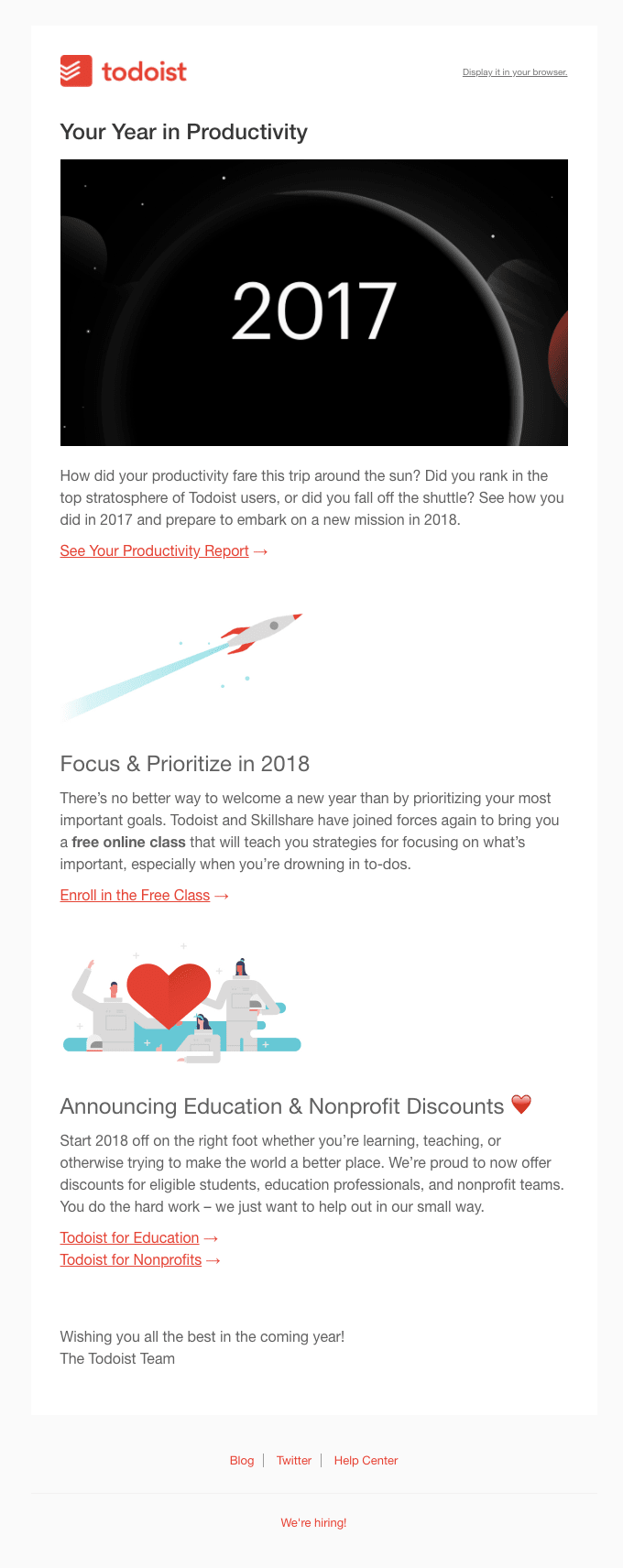
As a productivity platform, Todoist needs to ensure its users understand the full value its software provides. In other words, what they’ll be missing out on if they don’t continue paying that monthly subscription fee.
Make This a More Personal Year
With the examples we’ve looked at in this article, you should have all kinds of inspiration and ideas about how to create personalised customer experiences that add genuine value to engaging with your brand and buying from you on an ongoing basis. So make sure you’re not getting left behind by the brands already nailing personalisation and make this the year you get more personal with your customers.




